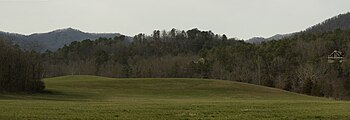 Looking downriver across the Too-Cowee site. | |
| Alternative name | Cowee [Stecoah] |
|---|---|
| Region | Macon County, North Carolina |
| Coordinates | 35°15′54″N 83°25′3″W / 35.26500°N 83.41750°W |
| History | |
| Cultures | South Appalachian Mississippian culture, historic period Cherokee |
| Architecture | |
| Architectural styles | platform mound |
| Architectural details | Number of temples: |
Cowee Mound and Village Site | |
| Area | 53 acres (21 ha) |
| Part of | Cowee-West's Mill Historic District (ID00001569) |
| NRHP reference No. | 73002238 (31Ma5) [1] |
| Significant dates | |
| Added to NRHP | January 18, 1973 |
| Designated CP | January 8, 2001 |
Too-Cowee (sometimes Cowee) (also Stecoah), was an important historic Cherokee town located near the Little Tennessee River north of present-day Franklin, North Carolina. It also had a prehistoric platform mound and earlier village built by ancestral peoples. As their expression of public architecture, the Cherokee built a townhouse on top of the mound. It was the place for their community gatherings in their highly decentralized society. The name translates to "pig fat" in English. British traders and colonists referred to Cowee as one of the Cherokee Middle Towns along this river; they defined geographic groupings based in relation to their coastal settlements, such as Charlestown, South Carolina.
The "Cowee Mound and Village Site", now within present-day Macon County, North Carolina, has been listed since 1973 on the National Register of Historic Places as an archeological site. Since 2006 it has been owned by the federally recognized Eastern Band of Cherokee Indians, based in North Carolina, which shares some conservation easements with the state.[2]
- ^ "National Register Information System". National Register of Historic Places. National Park Service. March 13, 2009.
- ^ "Cowee Mound preserved for future generations, historic interpretation". Smoky Mountain News. November 1, 2006. Retrieved January 28, 2021.